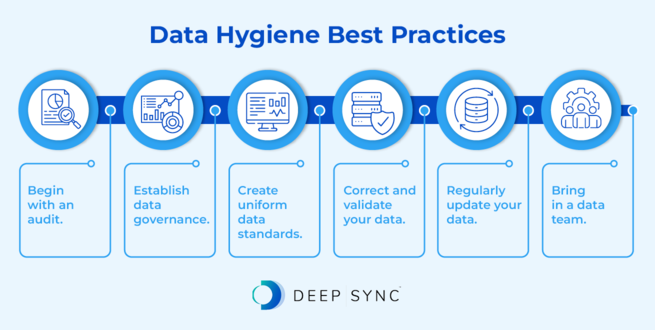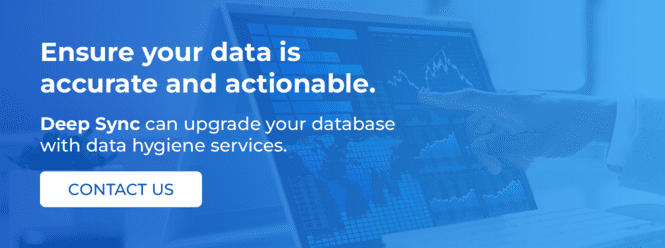Data is arguably the most powerful and valuable resource marketers can leverage. Target audience identification, direct mail strategies, and effective segmentation and personalization all depend on data-driven insights.
However, if you’ve ever interacted with data on any scale, you’ve likely realized that an outdated or incorrect database is less than helpful. As consumers move and change addresses, phone numbers, and email addresses, your customer data can quickly become unusable.
That’s where data hygiene comes in. In this guide, we’ll cover everything you need to know about cleansing your database, including:
Are you ready to transform your data into useful, actionable insights? Let’s get started.

What Is Data Hygiene?
Data hygiene is the process of keeping databases clean and error-free. Data that is outdated, incomplete, duplicated, or simply incorrect is known as “dirty data.”
We’ll explore why data cleanliness is essential in a bit, but first—what makes data dirty?
Dirty data is data containing errors—whether the information is outdated, incomplete, duplicated, or simply incorrect. Errors can occur at any point, but they’re not always someone’s fault. While it’s incredibly easy to introduce errors into your system, data can also become outdated when customers move or change their contact information. Considering the necessity of clean data, it’s crucial to maintain ongoing data hygiene practices.
A data hygiene solution improves the quality of your data by cleansing errors and irregularities, standardizing addresses, flagging undesirable profiles, and improving overall usability. Clean customer data provides a solid foundation for direct mail, online advertising, the application of additional data services, and more. For the best results, we recommend that every data hygiene plan includes:
- Conducting an audit or Data Quality Report to assess your current data
- Establishing data governance
- Creating uniform standards (like abbreviating “Street” to “St.”)
- Validating customer records and addresses against an external data source
- Suppressing unhelpful data (like deceased customers) and removing duplicate records
- Appending or enriching data to fill in the gaps in your database
For optimal results, data hygiene should not be a one-time process. Instead, establish a regular data hygiene routine to keep your data accurate and actionable.
Why Is Data Hygiene Important?
Businesses of all shapes and sizes make data-driven decisions every day. When that information is faulty, it has clear costs. In fact, those costs are around $12.9 million a year for organizations with poor data quality.
Marketing teams especially rely on accurate, clean data to engage in personalized campaigns that show the largest returns on investments (ROI). Inaccurate customer data can result in wasted resources, dissatisfied customers, and financial losses from missed revenue opportunities.
Needless to say, having clean data is crucial. Undergoing a robust data hygiene process brings several benefits to teams across your organization, such as:

- Informed decision-making. Clean, reliable data allows stakeholders and business leaders to make well-informed strategic decisions about their marketing outreach, product development, and customer engagement efforts.
- Increased efficiency. With a streamlined data management process, you can be confident that the data you’re using is accurate and up-to-date. As a result, you’ll increase the efficiency of a variety of internal processes, including lead generation, lead tracking, segmentation, and addressing customer service concerns.
- Reduced costs. Proper data hygiene prevents your organization from wasting resources by ensuring you send marketing communications to the right audience using updated contact information.
- Enhanced customer relationships. When you use updated customer data to personalize your marketing efforts, customers will have a more positive experience with your communications, leading to increased brand loyalty.
Data hygiene processes can also help organizations adhere to privacy regulations. For example, Do Not Mail and Do Not Call suppression can help companies respect their customers’ privacy.
6 Data Hygiene Best Practices
High-quality data is essential for operating a successful business. Here’s how to implement data hygiene best practices to ensure your data remains clean and actionable.

Begin with an audit.
The first step in creating ongoing data hygiene procedures is completing an audit of your database. A realistic view of the current state of your data can help you determine the next steps to take.
An audit, like a Data Hygiene Report, looks at your data and determines counts of unique individuals and households, where additional personal information (including names, postal addresses, telephone numbers, and email addresses) can be added, and more. This step can help you determine if additional data points are needed and which areas of your database are most in need of help.
Once you’ve identified where problems exist, continue forward with the next steps to focus on parsing out that information bit by bit.
Establish data governance.
Data quality is everyone’s responsibility. From frontline employees to C-suite leadership, the practices for handling customer contact information, mission-critical data, and proprietary materials are vital to an organization’s success.
A proper data governance framework can help keep your database in order and ensure your data stays high quality. It’s crucial to designate a data steward who is responsible for master data files and special data hygiene projects.
Furthermore, a standard operating procedure (SOP) should accompany initial training for new hires. These SOPs designate data ownership, management processes, and the consequences of non-compliance.
With senior leadership buy-in and a focus on data management, you can improve your data’s quality throughout collection, storage, and manipulation—ensuring that information is as accurate as possible.
Create uniform data standards.
Dirty data isn’t the only problem that data hygiene solves; a data hygiene process can correct inconsistencies that occur throughout data collection and manual data entry.
Close attention to detail is essential in data hygiene. When it comes to cleansing your database, do sweat the small things. Small inconsistencies in your data can make it difficult to use your data, confuse team members, or result in duplicate records.
To prevent these inconsistencies, set uniform standards across your organization. Include these standards in every team member’s training. Ensure that you cover how to standardize:
- Mailing addresses. From non-standard formatting to consumer moves, addresses are a common point where small details can quickly get derailed. Standardization in this area is especially essential if you’re doing any direct mailings or location-based marketing. For example, decide if you want to use address abbreviations like “St.” or the non-abbreviated “Street.”
- Phone numbers. There are many ways to enter a phone number. Do you need the country code, or are all of your contacts in your country? Will you put parenthesis around the area code, or omit them? Standardizing how you enter phone numbers can ensure you’re able to effectively reach your contacts.
- Titles, common abbreviations, and more. Consider the data you enter into your database; many things can be abbreviated, shortened, or entered in multiple ways. Do you want “CEO” spelled out, or does the acronym suffice? Will you list contacts as “Junior” or “Jr.”? Think through fields that may result in inconsistencies, and address them accordingly.
Implementing consistent formatting for data entry across all departments can keep your data clean between data hygiene processes.
Correct and validate your data.
Even with the best standard operating procedures (SOPs) and data hygiene processes, how can you be sure your data is correct?
A reputable data partner can cleanse residential postal addresses and provide updated postal addresses where applicable. Data providers commonly use services such as CASS™ System, DSF2®, LACSLINK®, and NCOALINK® for address verification. Providers can also transform messy, fragmented data into accurate and unified customer records.
While cleansing and correcting your current data is crucial to a company’s success, it’s also helpful to enlist a data partner to suppress unhelpful data. Suppression services can rid your database of unuseful information including:
- Do Not Mail Suppression. Identify the names and addresses and/or email addresses of consumers who have registered with the ANA’s DMAChoice™ Program to eliminate direct marketing solicitations.
- Prison Suppression. Remove addresses that are associated with federal prisons, state prisons, county correctional facilities, and city jails throughout the United States.
- Deceased Suppression. Remove deceased individuals from your marketing efforts before a promotion to prevent unwanted mail from being delivered to the decedent’s family.
- Deduplication. Remove name, address, email, and telephone records that appear multiple times in your system.
When it comes to data, more is not necessarily better. The data types discussed above are functionally useless when it comes to marketing initiatives and will clog up your business’s (or your clients’) databases.
Removing them from consideration during marketing initiatives will prevent wasted time following useless leads, excess postage, unwanted fines, and tarnishing your brand image.
Regularly update your data.
In the first half of 2023, 8,690,653 consumers reported an address change. As customers move, get married, change their email addresses and phone numbers, or change their names, companies must update their databases accordingly. Additionally, consumer data decay at an average rate of 25% – 30% per year, making routine data hygiene critical.
Deep Sync offers thorough and complete data hygiene solutions, including address verification and correction. We leverage the full United States Postal Service® deterministic truth set to validate residential postal addresses and provide updated addresses where applicable. This service is ideal for use independent of or in conjunction with National Change of Address processing.
Data hygiene should not be a one-time process. Creating processes for ongoing maintenance and uniformity is key. This includes:
- Standardization in data entry. Across the board, each data point in your system should be entered in a standard manner with clearly outlined rules dictating such.
- Handling of errors. How will your staffers handle duplicate entries? Incorrect or incomplete entries? Outline rules as such.
- Dirty data prevention. How will you prevent a build-up of unnecessary (or even, a lack of necessary) information in the future? Adding essential fields to your data collection forms, and removing nonessential fields, helps in this effort.
Simply outlining these procedures isn’t enough to ensure an optimized, useful database. Communicating these points across your business and guaranteeing everyone follows your new protocols can help minimize the amount of dirty data in the future. You’ll want to revisit these standards and check in on your database regularly, making sure the efforts you’ve expended are maintained.
Our Top Tip: Bring in a data team.
Whether you’re a business examining your own database or are a reseller assisting your clients, the process can be complicated. Most people don’t have the time, resources, or data expertise to execute a data hygiene project in-house.
While it’s technically possible to manually complete some of these efforts on your own, bringing in a team that specializes in data hygiene drastically eases the process.
Deep Sync handles data hygiene processes such as postal address hygiene, email address validation, suppression services, data quality reports, integrated identity resolution, and more.
Keep Your Data Clean With Deep Sync’s Data Hygiene Solutions
Marketing agencies, businesses, direct mailers—everyone is talking about the importance of data for building, maintaining, and growing your customer base. Simply having the data, however, isn’t enough to harness its power!
Maintaining your records with strong data hygiene practices will ensure they provide useful, actionable insights for years to come. With this guide, you’ll be off to a great start.
Don’t trust just anyone with your data hygiene needs, though. Instead, partner with Deep Sync. Our industry knowledge, expertise, exclusive partnerships, and robust data can help you ensure your database is as clean and actionable as possible. Contact us today to schedule your strategy session and start cleaning up your first-party data!
For more information about maintaining your database, explore these additional resources:
- First-Party Data: Leveraging Audience Insights. Proper data hygiene ensures your first-party data is accurate and actionable. Learn more about how you can collect, organize, and leverage this information.
- What Is Data Enrichment? How To Unlock Marketing Insights. Once you’ve applied data hygiene services to your database, you may notice you’re missing valuable information. Explore how you can flesh out your customer data with data enrichment.













0 Comments